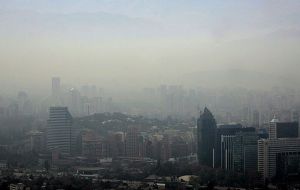MercoPress. South Atlantic News Agency
Santiago de Chile pollution has doubled in eight years
 The construction industry and the growing number of cars, main causes
The construction industry and the growing number of cars, main causes A new study by Universidad de Santiago de Chile (USACH) shows fine particulate matter from construction and traffic has more than doubled in the Santiago metropolitan region over the past eight years.
The USACH study uses data gathered by the National Environmental Commission (CONAMA) to measure levels of particulate matter (PM) and identify its source. Fine particulate matter (PM2.5) is particularly dangerous because its microscopic size means it is easily absorbed into the lungs and can cause a variety of health issues.
Ernest Gramsch, one of the authors of the study, told the Santiago Times the results show a small overall increase in the levels of PM2.5 – for which there is currently no regulation in Chile – but the make-up of the particulate has changed.
Gramsch explains there are five measurable sources making up PM2.5: sulphates; oils; exhaust; marine aerosols and dust. Since 2002, the amount attributed to dust has increased by 18%, now making up a total of 25% of source matter.
In some ways, the rise can be attributed to “progress,” in the form of construction and cars.
New housing, condominiums and highway construction have all been on the rise in Chile, particularly in the Santiago region. President Michelle Bachelet’s government recently boasted about the number of subsidies given to the housing market.
According to the Chilean daily El Mercurio, construction has increased 4.2% a year and the number of cars increases at the rate of 6.5% per year.
Construction sites dig up the fine dust into the atmosphere and because the matter is so small it hangs in the air longer, where it is likely to be moved around by wind.
Regulations on exhaust emissions, the change to unleaded gas and newer cars have lessened the direct impact of PM2.5 emissions. However more Chileans are buying cars and the overall increase in the number of vehicles circulating in the city mean more traffic – and that means more dust in the air, says Gramsch.
Overall Santiago suffers worse pollution, including higher levels of sulphates, during winter months when there is less wind in the central valley.
These types of studies are important, says Gramsch, so that the source of the pollutants, in this case construction and the number vehicles on the road, can be controlled.
By Pamela Morales - Santiago Times




Top Comments
Disclaimer & comment rulesCommenting for this story is now closed.
If you have a Facebook account, become a fan and comment on our Facebook Page!